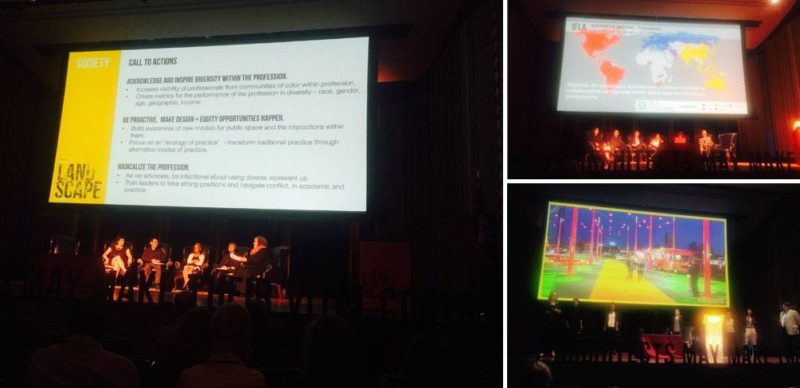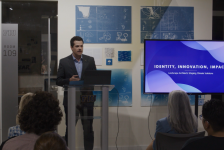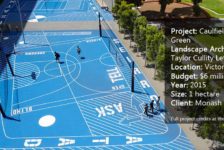The Future of Landscape Architecture – Landscape Architects Network team member Brett Lezon reflects on “The New Landscape Declaration: A Summit on Landscape Architecture and the Future“. It’s been 50 years since Ian McHarg and other leading landscape architects composed the Landscape Architecture Foundation’s (LAF) seminal Declaration of Concern, which decried the burgeoning environmental crisis and heralded landscape architecture as critical to help solve it. Much has changed since then, and on June 10-11, 2016 the LAF met again at the University of Pennsylvania in Philadelphia to reflect on the past and look forward to the future of landscape architecture. Titled “The New Landscape Declaration: A Summit on Landscape Architecture and the Future”, this symposium featured an all-star cast of over 65 leaders from around the globe that made bold claims on what’s forthcoming in the industry. Attended by over 700 people, it was an impressively historic event from which I came away with more questions than answers. However, before diving into more detail, here are some of my key takeaways from the panel discussions on the second day of the Summit.
Key Takeaways from the Panels:
- Climate change is worse than we want to admit
- Policy implementation has significant room for growth
- Racial and cultural diversity must improve within the profession
- The general public [still] lacks a clear understanding of what landscape architects really do (strong need for greater advocacy and activism)
The Future of Landscape Architecture
Ecology Panel
After an interesting discussion on aesthetics, the ecology panelists each went through a series of words (more on this later) that described the current state of our environment. While this approach was effective, what really got me thinking was the story about the impending sea level rise in San Francisco as mentioned by Kristina Hill, Associate Professor of Landscape Architecture & Environmental Planning and Urban Design at the University of California, Berkeley. Essentially, there was talk of a projected 8-foot sea level rise for the year 2100 which led to obvious concern and ultimately a panel was held to clarify. Based on sea level rise data, the studies expected a 3-foot rise by 2100. However, as she contends, we have to begin planning now. “Cities need to start planning now for impacts that will happen 50 or 100 years in the future,” said Hill.
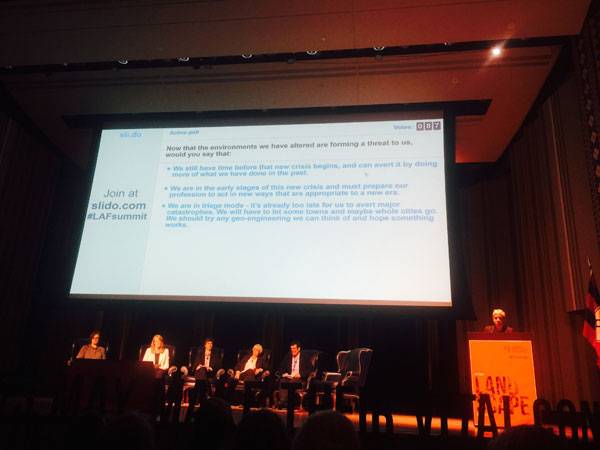
Poll question to the audience from Ecology Panel. Credit: Brett Lezon
Public Practice Panel
Featuring a strong group of practitioners from a former mayor to several professionals who are working with nonprofit organizations, the panel discussed a host of pressing topics including how to push initiatives forward, funding streams, and the misunderstanding of public practice as a “less than desirable” setting for recent graduates. Mark Focht had lots of wisdom to share, as his experience transcends the private and public sectors. Most notable are his efforts with the Philadelphia Parks and Recreation where he assisted in the implementation of a strategic stormwater plan for Philadelphia.
Society Panel
The jury has been out for years, but the profession must diversify. I don’t have a grand vision for addressing this, but initiatives such as the ACE Mentor Program Legacy Project, which has been active since 2008, is a good start. Additionally, the panel brought it up time and time again, but the profession already has some exceptional role models that should be leveraged to attract new, young students into landscape architecture. Perhaps Kate Orff, founder of SCAPE, said it best. Orff believes that the “physical program and social program should be linked to create a stronger tie to the community.”

Call to Actions from Society Panel. Credit: Brett Lezon
Capacity Organizations Panel
A well-represented panel consisting of leadership from the International Federation of Landscape Architects (IFLA), the American Society of Landscape Architects (ASLA), the Landscape Architecture Foundation (LAF), the Canadian Society of Landscape Architects (CSLA), the Urban Land Institute (ULI), and the charitable organization known as Public Architecture made for an intriguing discussion. Among the topics discussed include the need to collectively share information across groups about best practices for organizational structures, working more closely with allied partners, and how to involve and encourage African-American students and how to reach out to low-income communities about landscape architecture.
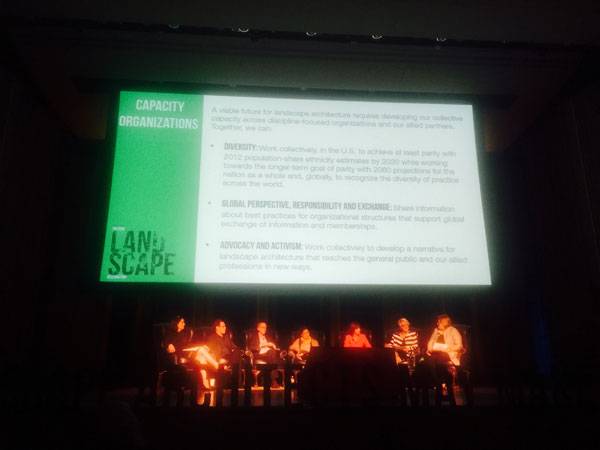
Call to Actions from Capacity Organizations Panel. Credit: Brett Lezon
Why Should We Care?
While there are several reasons we as landscape architects should fully support the Summit’s endeavors—it’s really about the bigger picture. First, the planet is becoming increasingly urban. Figures from the United Nation’s DESA’s Population Division report from 2014 illustrate that about 54% of the world’s population lives in urban areas. Early projections indicate that urbanization combined with overall growth could add an additional 2.5 billion people to urban areas—swelling the overall tally to 70% of the world’s population residing in urban areas. At the end of the day, landscape architects will be heavily relied upon to help sort out this massive growth, which leads to my next point. Second, with a dramatic uptick in urban population, cities will command inclusive public space more than ever. What I mean by “inclusive” is all-welcoming; to provide space for everyone to gather, picnic, play, read, dance, celebrate, etc. As noted by Nina Chase, placemaking will play a major role in providing public space as it’s mobile and can affect gradual, large-scale improvements while bringing identity to a place and promoting people’s health.

Aesthetics key takeaways. Credit: Brett Lezon
What I Wish Was Addressed?
While the conference was a two-day, jam-packed affair and all of the questions couldn’t be possibly answered—here are a few that I wish had been.
- Why do we have to use such complex jargon?
- How do we put this content into action with metrics and how do we measure levels of success?
- How does the finished proclamation reach a broader audience (a majority of landscape architects, designers, and allied professionals, educators, and students)?
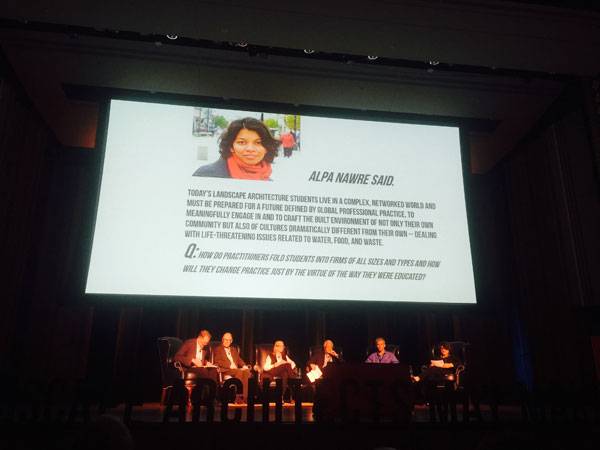
Private Practice Question. Credit: Brett Lezon



